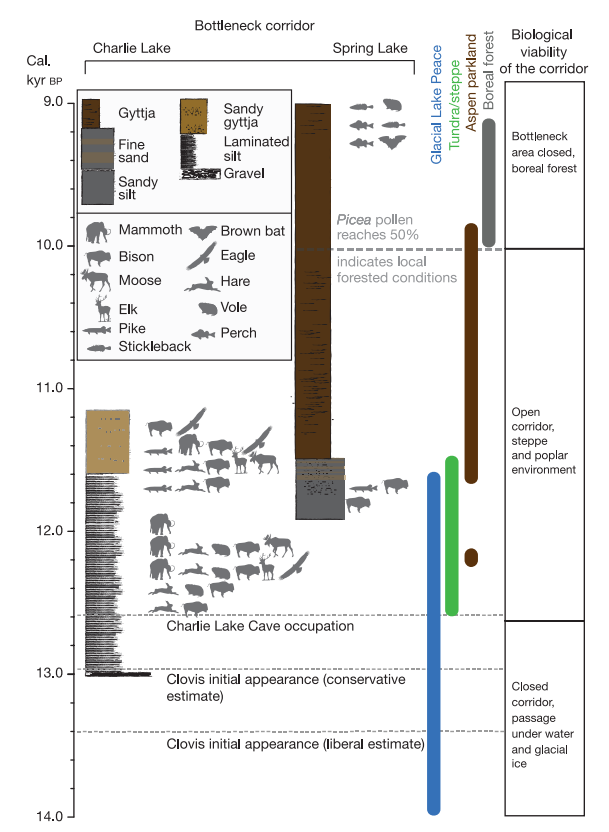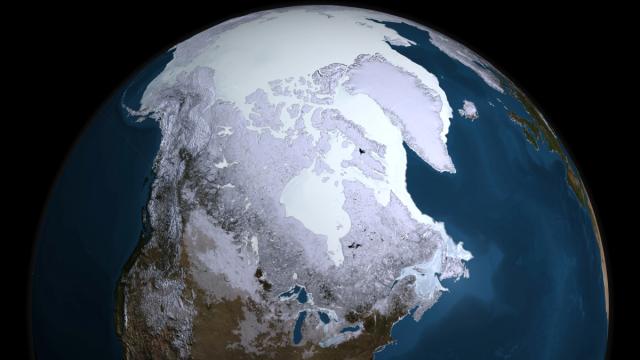It’s a veritable certainty that North America’s first people arrived via the Bering Land Bridge, but less certainty exists about how and where they migrated from there. For years, scientists thought they had travelled along an ice-free corridor in western Canada, but new research suggests that this was impossible.
Image: NASA
At the end of the most recent ice age, when the first North Americans arrived, the northwestern section of the continent was still covered in two immense ice sheets. As these sheets melted, a 1500km-long ice-free corridor appeared, opening up a potential migration route from Siberia through to Alaska and into the continental interior.
This ice-free corridor, located between the Cordilleran and Laurentide ice sheets in what is present day western Canada and much of the northern United States, was long thought to be the only way for humans to migrate into North America. But as a new study published in Nature points out, the maths simply doesn’t add up.

The ice-free corridor measured 1500 km long, and was no wider than several hundred kilometres.
An international team of researchers led by Eske Willerslev from the Natural History Museum of Denmark has concluded that, although the corridor opened up around 14,000 to 15,000 years ago, it remained free of vegetation and animals for thousands of years. Consequently, it was not able to sustain human migrants until much later, around 12,600 years ago. That presents a chronological problem for archaeologists because humans were already in the Americas by that time; evidence shows that humans were present in South America as long as 14,700 years ago.
This means they must have taken another route — and that route was likely along the Pacific coastline. These early North Americans made their way past the ice sheets by either walking along the ice-free sections of the coastal beaches, or more speculatively, by sea travel. Importantly, the authors of the new study say the ice-free corridor could have still been used as a migration route by other Asian settlers, particularly the Clovis people who entered North America between 13,400 to 12,800 years ago.
To reach this conclusion, Willerslev and his colleagues analysed nine sediment cores from Charlie Lake and Spring Lake in British Columbia and Alberta, which are located along the former corridor, and were among the last areas of the region to become ice-free. Using microscopy and radiocarbon dating, the researchers analysed the remnants of pollen and plants found in the core samples. DNA analysis was used to determine the biological timelines of both plants and animals.

A timeline showing how the corridor developed over time. The numbers along the lefthand column represent millions of years. (Image: Pedersen et al., 2016)
Looking at this data, the researchers estimate that sparse grasses and grass-like plants known as sedges appeared in the ice-free corridor no earlier than 12,700 years ago. But the key change to the landscape happened a hundred years later when it was colonised by grassland vegetation, turning the corridor into a veritable prairie, or steppe. By 12,400 years ago, this thin strip of land supported bison, and by 12,600 years ago it was home to small mammals such as hares and voles. Mammoths, elk and bald eagles arrived soon thereafter, signifying the onset of a rich food web.
The arrival of large fauna, such as bison and mammoths, was a critical turning point for the region because these creatures were hunted by early Americans. By 10,000 years ago, the region was covered in coniferous forest, making the region once again impassable to humans. Or at least, very difficult.

Of the four possible migration waves, only one is supported by the new data. (Image: Pedersen et al., 2016)
This research suggests there could have been two separate migration thrusts into North America, the first along the Pacific coastline around 15,000 years ago, and the second one when the ice-free corridor became habitable and human-friendly, around 12,600 years ago.
But this new data presents another intriguing possibility. Perhaps there was only one single migration wave along the West coast, but once the ice-free corridor became habitable, these early settlers started to make their way northwards through the corridor all the way back into Alaska. “Further investigations of ancient DNA may help resolve this issue,” the authors conclude.
[Nature]
